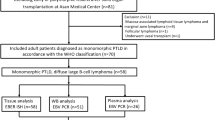Summary:
A 39-year-old male underwent a nonmyeloablative stem cell transplant (NMAPBPCT) from his HLA-matched sister for recurrent anaplastic large cell lymphoma in CR-2, receiving fludarabine, cyclophosphamide, and rabbit antithymocyte globulin for the preparative therapy. The patient was readmitted on day+33 for persistent culture-negative fevers. He rapidly developed marked elevations of alkaline phosphatase and bilirubin. Liver biopsy showed a periportal infiltrate of large immunoblastic appearing cells. The tumor cells did not stain for CD3/CD20/CD30 and alk protein, but did stain for CD79a/LCA and CD43. In situ hybridization for Epstein–Barr virus (EBV) RNA (EBER 1) was strongly positive in the periportal infiltrating lymphocytes. Fluorescence in situ hybridization (FISH) studies revealed female (XX) cells in the tumor cells and male (XY) in the surrounding hepatic parenchymal cells. The patient developed severe lactic acidosis, oliguric renal failure and expired on day+44. Both donor and patient had positive IgG serologies for EBV VCA and EBNA pretransplant. The donor also had a positive IgM titer for EBV VCA in the pretransplant specimen. The LPD may have been related to the intense immunosuppression of the preparative therapy and the presence of recent EBV infection in the donor.
This is a preview of subscription content, access via your institution
Access options
Subscribe to this journal
Receive 12 print issues and online access
$259.00 per year
only $21.58 per issue
Buy this article
- Purchase on Springer Link
- Instant access to full article PDF
Prices may be subject to local taxes which are calculated during checkout



Similar content being viewed by others
References
O'Reilly RJ, Small TN, Papadopoulos E et al. Biology and adoptive therapy of Epstein Barr virus associated lymphoproliferative disorders in recipients of marrow allografts. Immunol Rev 1997; 157: 195–216.
Curtis RE, Travis LB, Rowlings PA et al. Risk of lymphoproliferative disorders after bone marrow transplantation: a multi-institutional study. Blood 1999; 94: 2208–2216.
Ho AYL, Adams S, Shaikh H et al. Fatal donor derived Epstein–Barr virus-associated post-transplant lymphoproliferative disorder following reduced intensity volunteer related bone marrow transplant for myelodysplastic syndrome. Bone Marrow Transplant 2002; 29: 867–869.
Milpied N, Coste-Burel M, Accard F et al. Epstein–Barr virus associated B cell lymphoproliferative disease after non-myeloablative allogeneic stem cell transplantation. Bone Marrow Transplant 1999; 23: 629–630.
Bishop MR . Non-myeloablative allogeneic hematopoietic stem cell transplantation as adoptive cellular therapy. In: Rosenberg SA (ed.). Principles and Practice of Biologic Therapy of Cancer. Lippincott Williams and Wilkins Healthcare: New York, 2001, pp 1–9.
Slavin S, Nagler A, Naparstek E et al. Nonmyeloablative stem cell transplantation and cell therapy as an alternative to conventional bone marrow transplantation with lethal cytoreduction for the treatment of malignant and non-malignant hematologic diseases. Blood 1998; 91: 756–763.
Spitzer TR, McAfee SL, Sackstein R et al. Induction of mixed chimerism and potent anti-tumor responses following non-myeloablative conditioning therapy and HLA matched and mismatched donor bone marrow transplantation for refractory hematologic malignancies. Blood 1998; 92: 519 (abstract 2134).
Eiermann TH, Lambrecht P, Zander AR . Monitoring anti-thymocyte globulin (ATG) in bone marrow recipients. Bone Marrow Transplant 1999; 23: 779–781.
Remberger M, Svahn BM, Lofgren C, Ringden O . Effect on cytokine release and graft versus host disease of different T cell antibodies during conditioning for unrelated hematopoietic stem cell transplant. Bone Marrow Transplant 1999; 24: 823–830.
Gulley ML . Molecular diagnosis of Epstein Barr virus related diseases. J Mol Diag 2001; 3: 1–10.
Strauss SE, Cohen JI, Tosato G, Meier J . Epstein Barr Virus infections: biology, pathogenesis and management. Ann Intern Med 1993; 118: 45–58.
van Esser JWJ, Niesters HGM, van der Holt B et al. Prevention of Epstein–Barr virus-lymphoproliferative disease by molecular monitoring and preemptive rituximab in high risk patients after allogeneic stem cell transplantation. Blood 2002; 99: 4364–4369.
Author information
Authors and Affiliations
Rights and permissions
About this article
Cite this article
Zamkoff, K., Bergman, S., Beaty, M. et al. Fatal EBV-related post-transplant lymphoproliferative disorder (LPD) after matched related donor nonmyeloablative peripheral blood progenitor cell transplant. Bone Marrow Transplant 31, 219–222 (2003). https://doi.org/10.1038/sj.bmt.1703838
Received:
Accepted:
Published:
Issue Date:
DOI: https://doi.org/10.1038/sj.bmt.1703838
Keywords
This article is cited by
-
Risks and Mechanisms of Oncological Disease Following Stem Cell Transplantation
Stem Cell Reviews and Reports (2010)
-
Posttransplant lymphoproliferative disease: Pathogenesis, monitoring, and therapy
Current Oncology Reports (2003)



